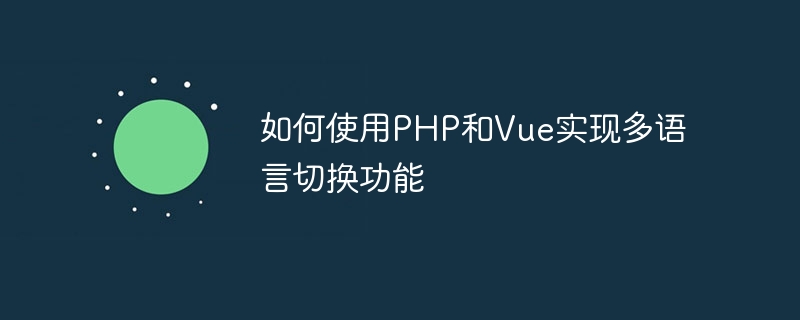Home >Backend Development >PHP Tutorial >How to use PHP and Vue to implement multi-language switching function
How to use PHP and Vue to implement multi-language switching function
- WBOYWBOYWBOYWBOYWBOYWBOYWBOYWBOYWBOYWBOYWBOYWBOYWBOriginal
- 2023-09-24 11:29:021293browse

How to use PHP and Vue to implement multi-language switching function
In today's Internet era, multi-language functionality has become a need that cannot be ignored. Whether it is a website or a mobile application, you will be faced with the need to support multiple languages. This article will introduce how to use PHP and Vue to implement multi-language switching function, and provide specific code examples.
- Preparation
First, we need to prepare the development environment. Make sure you have installed PHP and Vue-related development tools, such as the PHP interpreter and Vue-cli. - Create language files
Create a folder in the project to store translation files in different languages. For example, we can create a folder called "lang" and create multiple files in it, each file representing a language. Each file stores specific translation content in the form of key-value pairs.
For example, create a file named "zh_CN.json" with the following content:
{
"hello": "你好",
"welcome": "欢迎"
}At the same time, you can also create a file named "en_US.json" with the following content As follows:
{
"hello": "Hello",
"welcome": "Welcome"
}More language files can be created as needed.
- Create Vue component
In the Vue project, create a component for displaying text. For example, we can create a component called "Translation.vue".
<template>
<div>
<p>{{ $t('hello') }}</p>
<p>{{ $t('welcome') }}</p>
</div>
</template>
<script>
export default {
name: "Translation"
}
</script>In the above code, we use the $t directive to get the translated text. This is a built-in directive provided by the Vue-i18n library.
- Create language switching function
In the Vue project, we can use the Vue-i18n library to implement the multi-language switching function. First, we need to install the Vue-i18n library. Install the Vue-i18n library into the project by running the following command:
npm install vue-i18n --save
In the entry file of the Vue project, we need to add the following code:
import Vue from 'vue';
import VueI18n from 'vue-i18n';
Vue.use(VueI18n);
const i18n = new VueI18n({
locale: 'zh_CN', // 默认语言
messages: {
zh_CN: require('@/lang/zh_CN.json'), // 导入中文语言文件
en_US: require('@/lang/en_US.json') // 导入英文语言文件
}
});
new Vue({
router,
i18n,
render: h => h(App)
}).$mount('#app');In the above code , we first need to import the VueI18n library and register it into the Vue instance. Then, by creating a new VueI18n instance, we set the default language to "zh_CN" and imported the Chinese and English language files.
- Improving the multi-language switching function
In order to implement the multi-language switching function, we can create a drop-down menu for selecting languages.
In the Translation.vue component, add the code for the drop-down menu:
<template>
<div>
<select v-model="$i18n.locale" @change="handleChange">
<option value="zh_CN">中文</option>
<option value="en_US">English</option>
</select>
<p>{{ $t('hello') }}</p>
<p>{{ $t('welcome') }}</p>
</div>
</template>
<script>
export default {
name: "Translation",
methods: {
handleChange() {
// ...
}
}
}
</script>In the above code, we used the v-model directive to pull down the menu The value of the menu is bound to $i18n.locale, which is a built-in property provided by the Vue-i18n library. Then, we can listen to the language switching event in the handleChange method and switch the content of the page according to the selected language.
- Complete event processing of language switching
In thehandleChangemethod, we need to refresh the content by reloading the page to display the translation results of the selected language. We can use thewindow.location.reload()method to reload the page.
handleChange() {
window.location.reload();
}- Complete the multi-language switching function
So far, we have completed all the steps to implement the multi-language switching function using PHP and Vue. Now, run the Vue project and you will see a drop-down menu for selecting a language. By selecting a different language, the text content on the page will also switch accordingly.
Through the above steps, we successfully implemented the multi-language switching function using PHP and Vue. In actual projects, we can add more language files as needed and implement multi-language switching through the translation instructions and attributes provided in the Vue-i18n library. At the same time, we can also customize the drop-down menu for language selection to be more beautiful. The implementation of the multi-language switching function provides a better user experience for users of different languages and lays the foundation for the internationalization of the project.
(Note: The above is just a simple example, actual projects may require more configuration and function implementation)
The above is the detailed content of How to use PHP and Vue to implement multi-language switching function. For more information, please follow other related articles on the PHP Chinese website!

